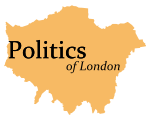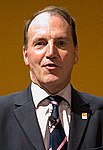| |||||||||||||||||||||||||||||||||||||||||||||||||||||
| Turnout | 36.95% | ||||||||||||||||||||||||||||||||||||||||||||||||||||
|---|---|---|---|---|---|---|---|---|---|---|---|---|---|---|---|---|---|---|---|---|---|---|---|---|---|---|---|---|---|---|---|---|---|---|---|---|---|---|---|---|---|---|---|---|---|---|---|---|---|---|---|---|---|
| |||||||||||||||||||||||||||||||||||||||||||||||||||||
 First preference votes by London borough. Blue boroughs are those with most first preference votes for Steven Norris and red those for Ken Livingstone | |||||||||||||||||||||||||||||||||||||||||||||||||||||
| |||||||||||||||||||||||||||||||||||||||||||||||||||||
| This article is part of a series within the Politics of England on the |
| Politics of London |
|---|
 |
The 2004 election to the post of Mayor of London took place on 10 June 2004. It was being held on the same day as other local elections and the UK part of the 2004 European Parliament elections, so Londoners had a total of five votes on three ballot papers. Polling opened at 07:00 local time, and closed at 22:00. See: 2004 UK elections. The Supplementary Vote system was used.
Ken Livingstone gained the Labour party's nomination on 2 January 2004, three weeks after being re-admitted to the Labour Party, after deputy Mayor Nicky Gavron, the previous candidate-elect, stepped down in favour of Livingstone.
Cite error: There are <ref group=lower-alpha> tags or {{efn}} templates on this page, but the references will not show without a {{reflist|group=lower-alpha}} template or {{notelist}} template (see the help page).




